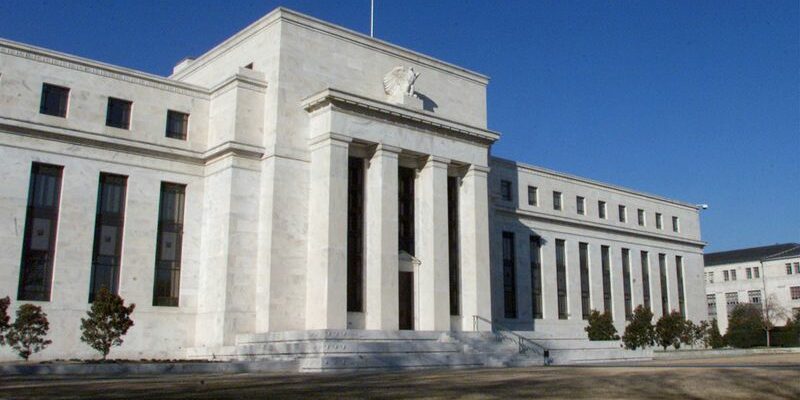by Howard Schneider and Ann Saphir
WASHINGTON (Reuters) – The US Federal Reserve (Fed) kept its key rates unchanged on Wednesday for the fifth consecutive time, but indicated that it still planned to reduce them by three-quarters of a percentage point this year, despite forecasts more modest on the fall in inflation.
Speaking after the publication of the American central bank’s press release, its president, Jerome Powell, stressed at a press conference that recent figures showing high inflation have not changed the underlying “narrative” of easing. gradual pressure on prices in the United States.
He added, however, that recent data also did not boost the Fed’s confidence to the point that the battle against inflation was won.
In its monetary policy statement, the Fed presents inflation as still “high”, and updated quarterly economic projections show that the price index of personal consumption expenditures (PCE) excluding food and energy will increase at a rate of 2 .6% at the end of the year, compared to 2.4% in the projections published in December.
This does not prevent 10 of the 19 Fed officials from still forecasting a cut in the key rate of at least 75 basis points by the end of 2024, a median forecast set at this level for the first time in December and maintained despite recent data showing higher-than-expected inflation.
On Wall Street, stock indexes retained their initial gains immediately after the Fed’s announcements.
The dollar depreciated 0.16% against a basket of currencies, while the yield on ten-year U.S. Treasuries fell about 1.5 basis points, to 4.2827%.
The Dow Jones index ended up 1.03% at 39,512.13 points and the broader Standard & Poor’s 500 rose 0.89% to 5,224.62 points, while the Nasdaq Composite took 1.25%, to 16,369.40 points.
“The May meeting is not conducive to a cut, barring a financial mishap, as the (Fed Monetary Policy) Committee continues to seek to ensure that inflation returns to its target level before to begin the easing cycle,” analyzed Michael Brown, head of markets at Pepperstone.
In December, 11 Fed officials had already forecast three quarter-percentage-point cuts for 2024.
The Fed’s new projections, however, are accompanied by an upward revision of the outlook for the economy. Growth for this year is now expected at 2.1%, compared to only 1.4% forecast in December, while the unemployment rate should be at 4% at the end of the year, less than 4.1%. expected in December and barely more than the 3.9% unemployment rate recorded in February.
A HIGHER LONG-TERM RATE
The long-term policy rate, a key indicator, was raised by a tenth of a percentage point, from 2.5% to 2.6%, reflecting the view of some Fed officials that the he economy can withstand higher interest rates in the future.
The Fed launched its aggressive cycle of monetary tightening two years ago in response to a surge in inflation that eventually climbed to a 40-year peak. Since last July, the American central bank has decided to maintain its key rate in the 5.25%-5.50% range.
The Fed’s latest projections show that the median outlook gives a cut in the benchmark overnight interest rate of three-quarters of a percentage point in 2025, less than what was forecast last December, and by three-quarters point in 2026 as well, as planned three months earlier.
“Economic activity developed at a sustained pace. Job creation remained significant and the unemployment rate remained low,” wrote the Fed in its press release, which was unanimously approved.
The statement also reiterated that central bank officials are still waiting for “greater confidence” in the continued decline in inflation before making an initial cut in interest rates. This rhetoric was already used at the January 30-31 meeting and could be used again until the first drop in borrowing costs.
In a note, analysts at Oddo BHF Switzerland said they were not surprised by the Fed’s decisions, noting that disinflation was less strong than expected, that the impact of restrictive monetary policy was less significant than expected and that , since the start of the year, investors’ expectations have converged with the forecasts of the American central bank.
Oddo BHF says it anticipates Fed rate cuts of 25 basis points in June, September and December.
GRADUAL SLOWDOWN IN INFLATION
During his press conference, Jerome Powell stressed that, despite the unexpectedly strong inflation, the Fed’s outlook on price pressures remains relatively stable.
The recent inflation data “have not really changed the overall situation, which is one of inflation gradually decreasing, on a somewhat rocky path,” he said.
Jerome Powell also downplayed the significance of the indicators according to which the labor market was starting to be in difficulty.
“The job market is in good shape,” he said. “I don’t see any cracks right now” in the labor market which is recovering from the extreme imbalances following the start of the COVID-19 pandemic, he added.
“In many ways,” he noted, labor market conditions are “returning more to where they were in 2019.”
Regarding the Fed’s balance sheet, Jerome Powell indicated that the day was fast approaching when the central bank would slow the pace of liquidation of its portfolio.
“It will be appropriate to slow the pace of the liquidation fairly soon,” he said, referring to the Fed’s ongoing drawdown of bond holdings.
Jerome Powell stressed that slowing the pace of these cuts from the current pace of just under $100 billion per month would reduce the risk that the Fed goes too far and shakes up money markets.
(Howard Schneider and Ann Saphir, with contributions from Saqib Ahmed and Lindsay Dunsmuir; French version Claude Chendjou, edited by Jean Terzian)
Copyright © 2024 Thomson Reuters
